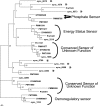Genome sequence of Synechococcus CC9311: Insights into adaptation to a coastal environment
- PMID: 16938853
- PMCID: PMC1569201
- DOI: 10.1073/pnas.0602963103
Genome sequence of Synechococcus CC9311: Insights into adaptation to a coastal environment
Abstract
Coastal aquatic environments are typically more highly productive and dynamic than open ocean ones. Despite these differences, cyanobacteria from the genus Synechococcus are important primary producers in both types of ecosystems. We have found that the genome of a coastal cyanobacterium, Synechococcus sp. strain CC9311, has significant differences from an open ocean strain, Synechococcus sp. strain WH8102, and these are consistent with the differences between their respective environments. CC9311 has a greater capacity to sense and respond to changes in its (coastal) environment. It has a much larger capacity to transport, store, use, or export metals, especially iron and copper. In contrast, phosphate acquisition seems less important, consistent with the higher concentration of phosphate in coastal environments. CC9311 is predicted to have differences in its outer membrane lipopolysaccharide, and this may be characteristic of the speciation of some cyanobacterial groups. In addition, the types of potentially horizontally transferred genes are markedly different between the coastal and open ocean genomes and suggest a more prominent role for phages in horizontal gene transfer in oligotrophic environments.
Conflict of interest statement
Conflict of interest statement: No conflicts declared.
Figures



References
-
- Wood A. M., Phinney D. A., Yentsch C. S. Mar. Ecol. Prog. Ser. 1998;162:25–31.
-
- Olson R. J., Chisholm S. W., Zettler E. R., Armbrust E. V. Deep-Sea Res. 1988;35:425–440.
-
- Olson R. J., Chisholm S. W., Zettler E. R., Armbrust E. V. Limnol. Oceanogr. 1990;35:45–58.
-
- Wood A. M., Lipsen M., Coble P. Deep-Sea Res. II. 1999;46:1769–1790.
-
- Carpenter E. J., Guillard R. R. L. Ecology. 1971;52:183–185.
Publication types
MeSH terms
Substances
Associated data
- Actions
LinkOut - more resources
Full Text Sources
Other Literature Sources
Molecular Biology Databases

